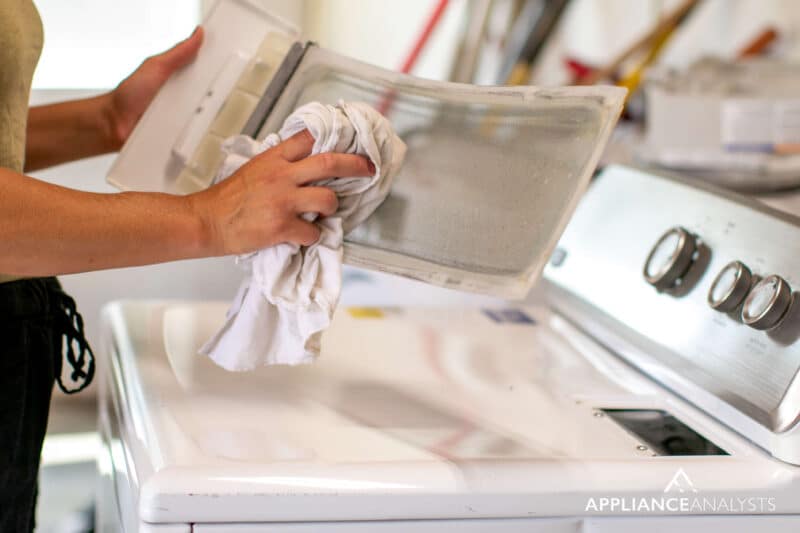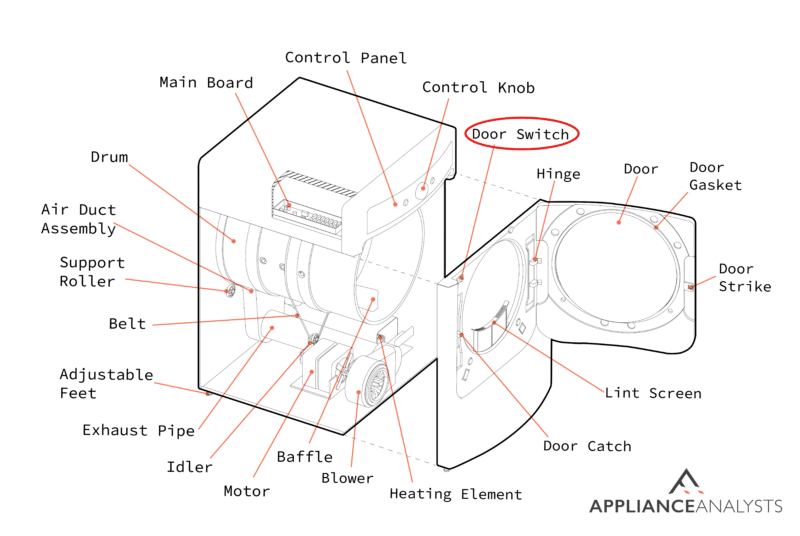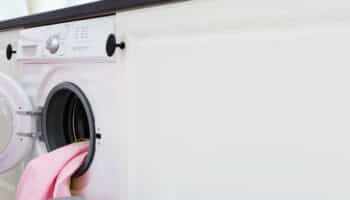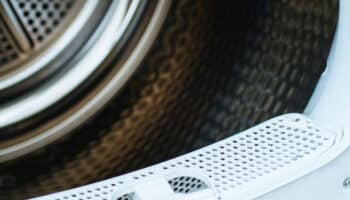We've independently reviewed this article to make sure it's as accurate as we can make it.
To find out more about our article creation and review process, check out our editorial guidelines.
On average, most dryers can reach temperatures of up to 225 degrees during a cycle. If your dryer is old or breaking, it can have trouble regulating its temperature and reach dangerously hot levels.
To cool down a dryer that is getting hot, you’ll need to check the high-limit thermostat, thermistor, exhaust vent, and airflow. One of these areas is likely causing issues, and you’ll need to fix them to regulate your dryer again.
Ready to learn how to cool your dryer down? Let’s dive straight in!
Fixing A Dryer That Gets Too Hot
When a dryer heats up, several parts help regulate its temperature so it doesn’t reach unsafe levels.
When you notice that your dryer is getting too hot to the touch, you’ll want to check on the following parts individually and rule out possible culprits.
#1 Improve Airflow
Airflow is essential to having a temperature-regulating dryer.
When airflow is blocked for any reason, the damp, hot air has no place to release. My usual advice is to check all the parts of your dryer that deal with airflow and ensure they work normally.
The exhaust vent I mentioned earlier is key to regulating your dryer temperatures, but so are the ducts, lint trap, and air blower.
The duct is where the dryer connects to the outside world to let all the hot air out. You’ll need to clean the duct periodically to ensure no debris or lint is left inside.
The lint trap is usually located on the top area of your dryer and should be cleaned after a big load or every other use. When the dryer gets too hot, it could potentially cause a fire with the build-up lint.

By checking all your different options, you can improve airflow and help cool down your dryer.
#2 Clean Your Exhaust Vent
Keeping your dryer’s exhaust vent clear is key to ensuring it works and doesn’t overheat.
In my experience, one of the easiest ways to clean your dryer’s vents is to unplug the dryer, detach your vent, and carefully vacuum out all the debris inside.
You should also look at your vent cap to see if there’s any blockage there.

An easy way to check for dryer airflow is to hold down the door switch (so the dryer thinks it’s closed) and start a cycle at low temperature.
Take a piece of paper and hold it under the lint trap.
If the dryer is trying to suck the piece of paper out of your hand and into the lint trap, you’re good. But if the paper is barely moving – poor airflow is likely to reason for the dryer being too hot.

If your dryer is exhausted through a pipe, blockages can commonly be found at the very top. Believe it or not, even bird nests blocking your dryer exhaust could be why your dryer is getting too hot!
#3 Make Sure Your High Limit Thermostat is Functioning
To keep your dryer from overheating, a “high-limit thermostat” component will trip the electricity to your dryer and cause it to shut off completely. The thermostat trips your breakers, so the temperature never gets so hot that it might cause a fire.
However, as mentioned in the above section, if you never clean out your exhaust vent, the high-limit thermostat might blow over time, and the dryer won’t turn on or heat.
In cases of a blown high-limit thermostat, you should look for a replacement.
If you want to get any replacement part – or see how much one would cost – click to enter your model number in the search bar below. Our partners at AppliancePartsPros stock almost every part with free guides on how to install them.

#4 Check your Cycling Thermostat
A cycling thermostat is the part of your dryer that raises the internal temperature and helps dry your clothes. The thermostat helps regulate the temperature of the dryer, but it can also be faulty and make the dryer hotter than usual.
Checking the cycling thermostat is a good practice that can help you identify whether it’s causing your dryer to overheat. The cycling thermostat has the ability to open and close the electrical current to the heating element in your dryer.
As the temperatures start to get too high, the cycling thermostat opens up and causes the heating element to turn off, killing all electricity in the area where the element is located.
When the temperatures start to cool off, the cycling thermostat closes back up, allowing the heating element to turn on again.
If you’re not sure how to check your cycling thermostat, I recommend you check your User Manual for specific instructions on the part’s location and wiring. Provided you don’t feel confident taking on the task yourself, you can always contact a professional and let them handle the job.
#5 Thermistor Issues
The thermistor is relevant to many late-model dryers with a solid-state device that regulates the temperatures inside them.
The thermistor is hooked up to your dryer’s control board and receives electric signals from the control board to turn the heating element on and off.
Unfortunately, the thermistor can’t be inspected without taking the dryer apart and using a multimeter.
From what I’ve seen, poor communication between the control board and the thermistor can cause many temperature problems.
You can see the correct thermistor resistance at room temperature in your owner’s manual. Then, use a multimeter to check if the thermistor has the right resistance. If you don’t have your owner’s manual handy, feel free to use our resource below.
Cooling Down Your Dryer
When a dryer is too hot, you must check out the parts that deal with the dryer’s temperature regulation. Otherwise, your dryer could cause an even bigger problem, like a fire.
The cycling thermostat, high limit thermostat, thermistor, exhaust vent, and airflow are all problem areas to check. By cleaning and possibly replacing the components, you should have regular temperatures in your dryer in no time.
Thanks for reading. If you found this article helpful, please check out our other incredible resources below and consider subscribing to our newsletter.
Have a great day!
-Craig.
Frequently Asked Questions
How Hot Should A Dryer Be?
Dryers typically range from 100-225 degrees Fahrenheit, generally enough to turn water into vapor to dry your clothes.
If you feel your dryer is getting hotter, you can use temperature gauges to see what the exact temperature of your dryer is.
Is It Dangerous for a Dryer To Be Too Hot?
Yes, a dryer being too hot (above 225 degrees Fahrenheit) is a dangerous sign.
If you measure high temperatures consistently, you should stop using the dryer. Follow the tips in this article to try and DIY the issue. If our tips don’t work, please contact an appliance repair professional.








![LG Dryers: How to Change the Temperature [Easy Guide]](https://applianceanalysts.com/wp-content/uploads/2022/11/Featured-LG-Dryers-How-to-Change-the-Temperature-350x200.jpg)
